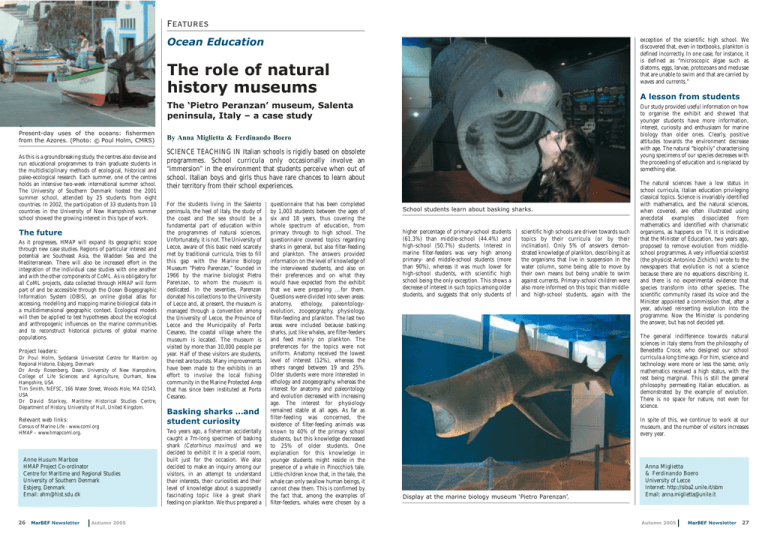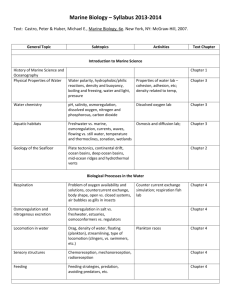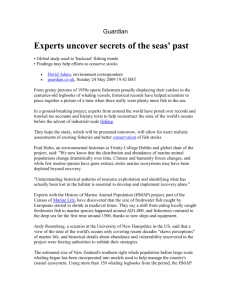Document 12260600
advertisement

Features exception of the scientific high school. We discovered that, even in textbooks, plankton is defined incorrectly. In one case, for instance, it is defined as “microscopic algae such as diatoms, eggs, larvae, protozoans and medusae that are unable to swim and that are carried by waves and currents.” The role of natural history museums A lesson from students The ‘Pietro Peranzan’ museum, Salenta peninsula, Italy – a case study Our study provided useful information on how to organise the exhibit and showed that younger students have more information, interest, curiosity and enthusiasm for marine biology than older ones. Clearly, positive attitudes towards the environment decrease with age. The natural “biophily” characterising young specimens of our species decreases with the proceeding of education and is replaced by something else. ' Poul Holm, CMRS Ocean Education Present-day uses of the oceans: fishermen from the Azores. (Photo: © Poul Holm, CMRS) As this is a groundbreaking study, the centres also devise and run educational programmes to train graduate students in the multidisciplinary methods of ecological, historical and paleo-ecological research. Each summer, one of the centres holds an intensive two-week international summer school. The University of Southern Denmark hosted the 2001 summer school, attended by 25 students from eight countries. In 2002, the participation of 33 students from 10 countries in the University of New Hampshire’s summer school showed the growing interest in this type of work. The future As it progresses, HMAP will expand its geographic scope through new case studies. Regions of particular interest and potential are Southeast Asia, the Wadden Sea and the Mediterranean. There will also be increased effort in the integration of the individual case studies with one another and with the other components of CoML. As is obligatory for all CoML projects, data collected through HMAP will form part of and be accessible through the Ocean Biogeographic Information System (OBIS), an online global atlas for accessing, modelling and mapping marine biological data in a multidimensional geographic context. Ecological models will then be applied to test hypotheses about the ecological and anthropogenic influences on the marine communities and to reconstruct historical pictures of global marine populations. Project leaders: Dr Poul Holm, Syddansk Universitet Centre for Maritim og Regional Historie, Esbjerg, Denmark Dr Andy Rosenberg, Dean, University of New Hampshire, College of Life Sciences and Agriculture, Durham, New Hampshire, USA Tim Smith, NEFSC, 166 Water Street, Woods Hole, MA 02543, USA Dr David Starkey, Maritime Historical Studies Centre, Department of History, University of Hull, United Kingdom. Relevant web links: Census of Marine Life - www.coml.org HMAP – www.hmapcoml.org. Anne Husum Marboe HMAP Project Co-ordinator Centre for Maritime and Regional Studies University of Southern Denmark Esbjerg, Denmark Email: ahm@hist.sdu.dk 26 MarBEF Newsletter Autumn 2005 By Anna Miglietta & Ferdinando Boero SCIENCE TEACHING IN Italian schools is rigidly based on obsolete programmes. School curricula only occasionally involve an “immersion” in the environment that students perceive when out of school. Italian boys and girls thus have rare chances to learn about their territory from their school experiences. For the students living in the Salento peninsula, the heel of Italy, the study of the coast and the sea should be a fundamental part of education within the programmes of natural sciences. Unfortunately, it is not. The University of Lecce, aware of this basic need scarcely met by traditional curricula, tries to fill this gap with the Marine Biology Museum “Pietro Parenzan,” founded in 1966 by the marine biologist Pietro Parenzan, to whom the museum is dedicated. In the seventies, Parenzan donated his collections to the University of Lecce and, at present, the museum is managed through a convention among the University of Lecce, the Province of Lecce and the Municipality of Porto Cesareo, the coastal village where the museum is located. The museum is visited by more than 10,000 people per year. Half of these visitors are students, the rest are tourists. Many improvements have been made to the exhibits in an effort to involve the local fishing community in the Marine Protected Area that has since been instituted at Porto Cesareo. Basking sharks …and student curiosity Two years ago, a fisherman accidentally caught a 7m-long specimen of basking shark (Cetorhinus maximus) and we decided to exhibit it in a special room, built just for the occasion. We also decided to make an inquiry among our visitors, in an attempt to understand their interests, their curiosities and their level of knowledge about a supposedly fascinating topic like a great shark feeding on plankton. We thus prepared a questionnaire that has been completed by 1,003 students between the ages of six and 18 years, thus covering the whole spectrum of education, from primary through to high school. The questionnaire covered topics regarding sharks in general, but also filter-feeding and plankton. The answers provided information on the level of knowledge of the interviewed students, and also on their preferences and on what they would have expected from the exhibit that we were preparing …for them. Questions were divided into seven areas: anatomy, ethology, paleontologyevolution, zoogeography, physiology, filter-feeding and plankton. The last two areas were included because basking sharks, just like whales, are filter-feeders and feed mainly on plankton. The preferences for the topics were not uniform. Anatomy received the lowest level of interest (12%), whereas the others ranged between 19 and 25%. Older students were more interested in ethology and zoogeography, whereas the interest for anatomy and paleontology and evolution decreased with increasing age. The interest for physiology remained stable at all ages. As far as filter-feeding was concerned, the existence of filter-feeding animals was known to 40% of the primary school students, but this knowledge decreased to 25% of older students. One explanation for this knowledge in younger students might reside in the presence of a whale in Pinocchio’s tale. Little children know that, in the tale, the whale can only swallow human beings, it cannot chew them. This is confirmed by the fact that, among the examples of filter-feeders, whales were chosen by a School students learn about basking sharks. higher percentage of primary-school students (61.3%) than middle-school (44.4%) and high-school (50.7%) students. Interest in marine filter-feeders was very high among primary- and middle-school students (more than 90%), whereas it was much lower for high-school students, with scientific high school being the only exception. This shows a decrease of interest in such topics among older students, and suggests that only students of scientific high schools are driven towards such topics by their curricula (or by their inclination). Only 5% of answers demonstrated knowledge of plankton, describing it as the organisms that live in suspension in the water column, some being able to move by their own means but being unable to swim against currents. Primary-school children were also more informed on this topic than middleand high-school students, again with the The natural sciences have a low status in school curricula, Italian education privileging classical topics. Science is invariably identified with mathematics, and the natural sciences, when covered, are often illustrated using anecdotal examples dissociated from mathematics and identified with charismatic organisms, as happens on TV. It is indicative that the Minister of Education, two years ago, proposed to remove evolution from middleschool programmes. A very influential scientist (the physicist Antonino Zichichi) wrote to the newspapers that evolution is not a science because there are no equations describing it, and there is no experimental evidence that species transform into other species. The scientific community raised its voice and the Minister appointed a commission that, after a year, advised reinserting evolution into the programme. Now the Minister is pondering the answer, but has not decided yet. The general indifference towards natural sciences in Italy stems from the philosophy of Benedetto Croce, who designed our school curricula a long time ago. For him, science and technology were more or less the same; only mathematics received a high status, with the rest being marginal. This is still the general philosophy permeating Italian education, as demonstrated by the example of evolution. There is no space for nature, not even for science. In spite of this, we continue to work at our museum, and the number of visitors increases every year. Display at the marine biology museum ‘Pietro Parenzan’. Anna Miglietta & Ferdinando Boero University of Lecce Internet: http://siba2.unile.it/sbm Email: anna.miglietta@unile.it Autumn 2005 MarBEF Newsletter 27






